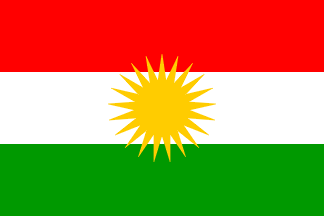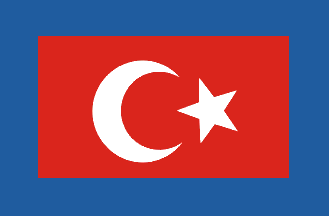 image by Ivan Sache
image by Ivan Sache
Last modified: 2023-03-11 by ian macdonald
Keywords: kurdistan | turkey | iran | iraq |
Links: FOTW homepage |
search |
disclaimer and copyright |
write us |
mirrors
The Kurds are the largest national group without a nation state. Since
the First World War, they have enjoyed three brief periods of
geographically-limited near-nationhood, but their own disunity has often
hindered progress. More importantly the existing regional powers have found
Kurdish nationhood threatening, and major powers like the United States have
shared that perspective.
Most of Kurdistan is now divided between Turkey, Iran and Iraq, and all three countries
have experienced numerous Kurdish insurgencies since 1920. Smaller pockets lie
in Syria, Armenia and Azerbaijan. There are major
communities of refugees throughout western Europe and the United States.
Kurdistan divides into two general socio-linguistic regions at the Greater Zab
River near the Iraqi-Turkish border:
(1) Northern Kurdistan is the Kurmanji-speaking region which mostly
lies in Turkey (most of eastern Anatolia). Since the 1980s, one of the PKK-related flags has
emerged as the principal flag representing Kurmanji Kurdistan.
(2) Southern Kurdistan is mostly Sorani-speaking and lies principally
in Iraq (north) and Iran (northwest). Also since the 1980s another flag seems to
have emerged as the most widely used for that region.
There is no central authority to legislate flags for Kurdistan, and until
very recently most Kurds did not seem interested in any precision about flags. I
have some friends who were very close to government officials of the former Mahabad Republic, and
they insisted 15 years ago that there was no Kurdish flag. They were surprised
when I presented historical evidence to the contrary.
T. F. Mills, 27 September 1997
This flag was introduced at the Paris Peace Conference of 1920, became the
flag of the short-lived Mahabad Republic of Kudistan from January–December 1946,
is widely used worldwide as a symbol of the Kurds wish for independence, and was
adopted by the Kurdistan Regional Government in Iraq on 10 June 1999. Precise
construction details were issued by the Centre for Kurdish Study, who also
define the colours as red 032, green 354 and yellow 116 in the Pantone Matching
System.
The flag has a 21-rayed sun in its centre, and this holds primary
importance in the native Yasdani religious tradition of the Kurds.
The
official construction details show a 2:3 horizontal tricolour of red, white and
gold with the centred sun being contained within an imaginary circle equalling
one-half of flag width, and a central disk one-half of that – in other words
4-4-4 for the width, and 18 for the length with the imaginary circles defining
the sun at 6 and 3.
Christopher Southworth, 8 April 2018
Similarly, there are two entities which claim to officially represent the Kurds:
Ivan Sache, 19 November 1999
 image by Jaume Ollé Casals, 1 July 2012
image by Jaume Ollé Casals, 1 July 2012
I saw the flag of the Kurdish militia that fought together the Turkish army against PKK on the Catalan TV channel TV3 on 21 February 1999, in a report about the conflict in Eastern Turkey.
Jaume Ollé Casals, 1 July 2012